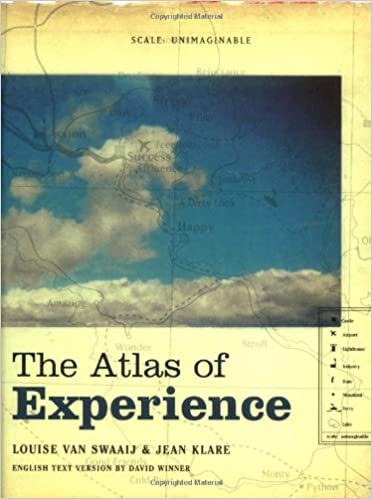The Atlas of Experience is a tourism destination that you are planning to visit. Look at the map. Find a place on the map that you are interested in visiting. Once you have decided where you will go, explain why you chose this destination. What were the reasons that this place was your first choice after reviewing the map?
I would visit the peninsula of “Pleasure.” My journey there would consist of me passing through “Growth,” climbing the “Mountains of Work,” experiencing “Stress” and “Negotiation.” But after a long road-trip along the highway of “Blood, Sweat and Tears” I will be rewarded in “Happy” and begin my “Wonderful Journey” around “Pleasure.” While there I hope to experience “Wonder” and enjoy “Long Evenings” with “Good Friends” and “Cold Beer.” While exploring the peninsula of “Pleasure” I would be surrounded by the Bay of Contentment, the Ocean of Peace and the Sea of Plenty. I choose this destination primarily for the journey that will bring me here. After experiencing lots of difficulties, I will go through a period of growth and after all of my hard work, I will reach a place of happiness and content. The experience of being in “Pleasure” will feel that much better because of the work I put into getting there.

I found this Atlas of Experience map really thought-provoking, it even inspired me to ask for the book for Christmas this year! I keep finding myself going back to it and looking at it from a new perspective. I had never thought about a map in a philosophical way before but this has really got me thinking. While doing some research after, I discovered Brian Harley’s 1989 article, Deconstructing the Map. In the article, he questions the reality of maps, dissects their meanings and explains how they are often rhetorical. I have a feeling that the creators of the Atlas of Experience book were also inspired by Harley’s article. He talks about how throughout history map-makers have often placed their homelands at the centre of their maps. As we can see on the World of Experience map, “Change” is illustrated in the middle. I can’t help but think that this was done on purpose, to symbolize how important and prevalent change is in our lives. Change is both rewarding and scary and I think that encompasses life quite poignantly. Another aspect of the World of Experience map that I can deconstruct in the same way that Harley does is the map’s borders. What catches my eye initially is the far Western border. I love how “Madness” falls outside of the map’s borders with the yellow border line representing the cut-off mark for sanity. In the article, Harley talks about how the selection, placement and omission of borders are often used to display power and control. He explains that borders are often portrayed differently depending on where the map was made. This makes me wonder if perhaps this yellow border would be moved if the book had been published in another part of the world that has different views on mental health? How the names of the destinations on the map are portrayed can also tell us a lot about what the mapmakers thought of them. Certain places are capitalized and bolded, whereas others are italicized and represented as more free-flowing. Even the colours of the map seem to allude to the negative or positive parts of life. I could talk about this map forever; it really fascinates me despite it being a dreamt-up land of places that don’t actually exist. I think this map really proves Harley’s point though that all maps really are, are just things and places we’ve made up and given importance to.